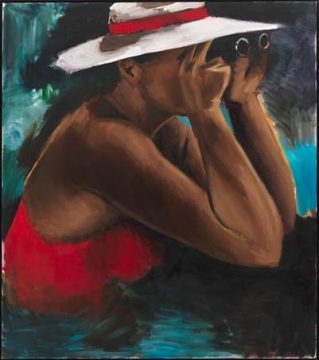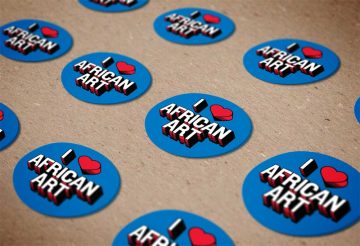300 Works of Art Seen Through Seven Perspectives

Womanology 12
2014, made in London
Oil on canvas
184.8 × 164.3 × 5.7 cm (72 3/4 × 64 11/16 × 2 1/4 in.)
Museum purchase, 2015-5-1
“Visionary” is organized around seven viewpoints, each of which serve to frame and affect the manner in which Africa’s art are experienced. With a room devoted to each viewpoint, the installation presents the museum’s collection from the perspective of collectors, scholars, artists, patrons, visitors, performers—and the museum itself. A range of interactive experiences within the gallery will connect visitors to the role such perspectives play in shaping the understanding of an object.
The exhibition will feature over 300 works of art, organized around the central activity of looking—looking closely at issues of technique and creative expression, looking broadly at the varied lives these assembled objects have lived and looking critically at how new contexts shift how we see art works. “Visionary” represents a broad range of Africa’s creative visual expressions. It will occupy the entirety of the museum’s multistory, second-floor gallery, covering nearly 6,000 square feet—re-anchoring the permanent collection at the heart of our programs and visitor experience.
Through the full range of media represented in the museum’s collection—assemblage, ceramics, costumes, drawing, jewelry, metalwork, sculpture, painting, performance, photography, printmaking and video—visitors will be encouraged to find visual and conceptual links between works by 21st- and 20th-century African artists and those made by earlier artistic predecessors. Over 30 named artists will be featured, including El Anatsui, Chike C. Aniakor, Osi Audu, Bamgboshe, Sokari Douglas Camp, Ajere Elewe, Ali Omar Ermes, Romuald Hazoumè, Gavin Jantjes, Mohamed Omer Khalil, Frank Marshall, Julie Mehretu, Magdalene Odundo, Ọlọ́wẹ̀ of Ise, Ouattara, Owusu-Ankomah, Sakadiba, Tchif, Iké Udé, Osman Waqialla, Susanne Wenger and Lynette Yiadom-Boakye.
Building on a series of recent, award-winning thematic exhibitions, “Visionary: Viewpoints on Africa’s Arts” marks a turning point in the museum’s interpretation and exhibition of its collection. Through this reimaging of the museum’s permanent collection, visitors are invited to expand their vision of what constitutes “art,” of how to engage an object and of how to see past the contexts that shape art’s reception.
Together, the exhibition’s seven featured perspectives offer new insights into the museum’s permanent collection, which has, for more than half a century, helped to shape what the world knows and values about Africa’s arts. With dedicated space for periodic rotations featuring new acquisitions, “Visionary” will offer a new and evolving stage on which to see Africa’s past and imagine its future.
Exhibition highlights include:
- Over 300 works from the museum’s permanent collection including 52 pieces from the Walt Disney-Tishman African Art Collection—many previously never exhibited
- More than 30 named artists from 27 African countries
- A “Looking Lab” that equips visitors to employ basic principles of visual analysis—and to see as artists do
- “Dense display” cases that evoke ‘open storage,’ inviting comparison across a range of objects
- A dedicated, rotating space for featuring new museum acquisitions, opening with major works new to the collection by artists Julie Mehretu, Frank Marshall and Lynette Yiadom-Boakye, among others, in their public debut
About the Curators
Kevin D. Dumouchelle joined the National Museum of African Art as curator in October 2016. From 2007 to 2016, he was the Brooklyn Museum’s curator in charge of African and Pacific Islands collections. At Brooklyn, he conceived two award-winning re-installations of the African collection: “African Innovations” (2011) and “Double Take: African Innovations” (2014). He has written books and articles and curated a range of exhibitions on both contemporary and historical African art, including “Power Incarnate: Allan Stone’s Collection of Sculpture from the Congo” (2011) at the Bruce Museum and the Brooklyn Museum presentations of “Gravity and Grace: Monumental Works by El Anatsui” (2013) and “Disguise: Masks and Global African Art” (2016).
Christine Mullen Kreamer, who currently serves as acting director of the National Museum of African Art, is the museum’s deputy director and chief curator. In addition to articles and essays on historic and contemporary African arts and museum practice, her recent award-winning exhibitions and co-authored publications include Conversations: African and African American Artwork in Dialogue (2014), African Cosmos: Stellar Arts (2012), Lines, Marks, and Drawings: Through the Lens of Roger Ballen (2013), Inscribing Meaning: Writing and Graphic Systems in African Art (2007) and African Vision: The Walt Disney-Tishman African Art Collection (2007). She is also a contributing author of an essay on connoisseurship in the 2014 edited volume Visions from the Forest: The Art of Liberia and Sierra Leone and two essays in Representing Africa in American Art Museums (University of Washington Press, 2011).
Karen E. Milbourne has been a curator at the National Museum of African Art since May 2008. Since joining the museum, she has curated critically acclaimed exhibitions, including the award-winning “Earth Matters: Land as Material and Metaphor in the Arts of Africa” (2013),” “Artists in Dialogue: António Ole and Aimé Mpane” (2009), “Artists in Dialogue 2: Sandile Zulu and Henrique Oliveira” (2011), “Senses of Time: Video and Film-based Arts of Africa,” “Emeka Ogboh’s Market Symphony,” and “Jim Chuchu Invocations” (2017). She was also coordinating curator for the exhibitions “Yinka Shonibare MBE” (2010), “Central Nigeria Unmasked” (2011), and “The Divine Comedy: Heaven, Purgatory, and Hell Revisited by Contemporary African Artists” (2015), and has published extensively on Africa’s modern and contemporary arts, and the arts and pageantry of western Zambia.
Educational Programs
Public programs will accompany the exhibition to engage the museum’s diverse audiences from K–12 to adult.
Community Day
The museum will host a Community Day Saturday, Nov. 4, from 10 a.m. to 5:30 p.m. in celebration of the public opening of “Visionary: Viewpoints on Africa’s Arts.” Visitors of all ages will be invited to experience special performances and events intended to inspire them to learn more about the people and cultures of Africa and its diaspora through music, books, dance, film and art. This event is free, and it will be presented in collaboration with a celebration of the Children’s Africana Book Awards.
About the National Museum of African Art
The National Museum of African Art is the nation’s premier museum dedicated exclusively to the collection, conservation, study and exhibition of Africa’s historic and contemporary arts. The museum is open daily from 10 a.m. to 5:30 p.m. (closed Dec. 25). Admission is free. The museum is located at 950 Independence Ave. S.W., near the Smithsonian Metrorail station on the Blue and Orange lines. For more information, call (202) 633-4600 or visit the National Museum of African Art’s website. For general Smithsonian information, call (202) 633-1000. Follow the museum on Twitter, YouTube, Instagram and Facebook. Join in the discussion on social media using #VisionaryAfrica.
Note to Editors: Selected images from “Visionary: Viewpoints on Africa’s Arts” may be downloaded by visiting the museum’s media website and clicking on “press room.” For media requests, contact Eddie Burke at (202) 633-4660 or burkee@si.edu.
